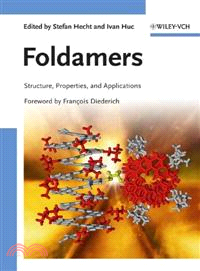Foldamers - Structure, Properties And Applications
商品資訊
定價
:NT$ 12375 元優惠價
:90 折 11138 元
若需訂購本書,請電洽客服 02-25006600[分機130、131]。
相關商品
商品簡介
作者簡介
名人/編輯推薦
目次
商品簡介
This truly comprehensive treatise of foldamers, from synthesis to applications in bio-, material-, and nanoscience is at once an introduction to the topic, while providing in-depth accounts on various aspects clearly aimed at the specialist.
The book is clearly structured, with the first part concentrating on structure and foldamer design concepts, while the second part covers functional aspects from properties to applications. The international team of expert authors provides overviews of synthetic approaches as well as analytical techniques.
The book is clearly structured, with the first part concentrating on structure and foldamer design concepts, while the second part covers functional aspects from properties to applications. The international team of expert authors provides overviews of synthetic approaches as well as analytical techniques.
作者簡介
Stefan Hecht obtained his doctorate in 2001 under the guidance of Professor Jean M. J. Frechet at the University of California at Berkeley. After working as a group leader at the Freie Universitat in Berlin and the Max-Planck-Institut Fur Kohlenforschung in Mulheim an der Ruhr, he recently returned to Berlin as Professor of Organic Chemistry and Functional Materials at the Humboldt Universitat. He is a recipient of the Sofia Kovalevskaja Award given by the Alexander von Humboldt Foundation, the MIT Technology Review Top 100 Young Innovator Award, and the ADUC Young Investigator Award of the German Chemical Society.
Ivan Huc received his PhD in 1994 from the University of Paris VI, jointly supervised by Dr. C. Rolando (Ecole Normale Superieure) and Professor J. Rebek Jr. (MIT). After a one year post-doctoral period with Dr. J.-P. Behr in Strasbourgillkirch, he joined Nobel prizewinner Professor J. -M. Lehn's laboratories in Strasbourg as a CNRS researcher. Since 1998, he has been a group leader at the Institut Europeen de Chimie et Biologie in Bordeaux, where he holds a CNRS research director position. Dr. Huc has received several scientific awards, including the bronze medal of the CNRS and the Acros prize awarded by the Organic division of the French Chemical Society.
Ivan Huc received his PhD in 1994 from the University of Paris VI, jointly supervised by Dr. C. Rolando (Ecole Normale Superieure) and Professor J. Rebek Jr. (MIT). After a one year post-doctoral period with Dr. J.-P. Behr in Strasbourgillkirch, he joined Nobel prizewinner Professor J. -M. Lehn's laboratories in Strasbourg as a CNRS researcher. Since 1998, he has been a group leader at the Institut Europeen de Chimie et Biologie in Bordeaux, where he holds a CNRS research director position. Dr. Huc has received several scientific awards, including the bronze medal of the CNRS and the Acros prize awarded by the Organic division of the French Chemical Society.
名人/編輯推薦
"Anyone who considers joining this field, or who just wants to know what is being done in the area, will be fortunate to have the efforts of editors Hecht and Huc at hand." (Angewandte Chemie International Edition, January 2008)
"…Foldamers is a delightful treatise on the subject area, provided that the reader is bent towards the biological realm. … Such versatility is hard to find, and the authors and editors should be commended for their hard work." (ChemMedChem, December 2007)
"…Foldamers is a delightful treatise on the subject area, provided that the reader is bent towards the biological realm. … Such versatility is hard to find, and the authors and editors should be commended for their hard work." (ChemMedChem, December 2007)
目次
Foreword.
Preface.
List of Contributors.
Part 1 Structure: Foldamer Design Concepts.
1 Foldamers Based on Local Conformational Preferences (Ivan Huc and Louis Cuccia).
1.1 Introduction.
1.2 Rigidly Locked Molecules.
1.3 Predictable Foldamers.
1.4 Semi-rigid Backbones.
1.5 Conformational Transitions.
1.6 Conclusion and Perspectives.
References.
2 Foldamers Based on Remote Intrastrand Interactions (Philippe Le Grel and Gilles Guichard).
2.1 Introduction.
2.2 What can be Learned from Strategies used to Control Conformations of α-Polypeptides?
2.3 Helices from Homogeneous Oligomeric Backbones with Periodicity at the Monomer Level: o-Peptides and their Analogs.
2.4 Oligoamide Mixed Helices.
2.5 Nonperiodic Structures: Open Chain b-Turn-like Motifs and Hairpins in Designed Homo-oligomers.
2.6 Expanding Structural Diversity with Heterogeneous Backbones.
2.7 Conclusion and Outlook.
References.
3 Foldamers Based on Solvophobic Effects (Yan Zhao and Jeffrey S. Moore).
3.1 Introduction.
3.2 Learning from Solvophobically Driven Assemblies – Intermolecular Solvophobic Interactions.
3.3 Learning from Synthetic and Biological Polymers.
3.4 Recent Advances in Foldamers Based on Solvophobic Effects.
3.5 Conclusions and Outlook.
References.
4 Foldamer Hybrids: Defined Supramolecular Structures from Flexible Molecules (Carsten Schmuck and Thomas Rehm).
4.1 Introduction.
4.2 Hybridization of Oligomers with Well-defined Structures.
4.3 Hybridization-induced Folding of Unstructured Molecules.
4.4 Formation of Large Polymeric Aggregates via Self-assembly.
4.5 Applications of Foldamer Hybridization.
4.6 Conclusion.
References.
5 Control of Polypeptide Chain Folding and Assembly (Rajkishor Rai and Padmanabhan Balaram).
5.1 Introduction.
5.2 Helix Promotion by Backbone Substitution.
5.3 Hairpin Design using Obligatory Turn Segments.
5.4 Helix–Helix Motifs.
5.5 Multi-stranded β-Sheets.
5.6 Mixed Helix-Sheet (α/β) Structures.
5.7 Conclusions.
References.
6 Simulation of Folding Equilibria (Wilfred F. van Gunsteren and Zrinka Gattin).
6.1 Introduction.
6.2 Dynamical Simulation of Folding Equilibria under Di.erent Thermodynamic and Kinetic Conditions.
6.3 Variation of the Composition of the Polypeptide Analogs and the Solvent.
6.4 Convergence of the Simulated Folding Equilibrium.
6.5 Sensitivity of the Folding Equilibrium to the Force Field Used.
6.6 Comparison of Simulated with Experimentally Measured Observables.
6.7 Characterization of the Unfolded State and the Folding Process.
6.8 Conclusion.
References.
Part 2 Function: From Properties to Applications.
7 Foldamer-based Molecular Recognition (Jorge Becerril, Johanna M. Rodriguez, Ishu Saraogi and Andrew D. Hamilton).
7.1 Introduction.
7.2 Small Molecule Recognition Using Foldamers.
7.3 Protein Recognition.
7.4 Mimicry of Biomineralization: Recognition of Crystal Surfaces Using Foldamers.
7.5 Conclusion.
References.
8 Biological Applications of Foldamers (Marc Koyack and Richard Cheng).
8.1 Introduction.
8.2 Design Strategies.
8.3 Outlook and Future Directions.
References.
9 Protein Design (Jean-Luc Jestin and Frédéric Pecorari).
9.1 Introduction.
9.2 Design of Proteins from Natural Sca.olds.
9.3 Design of Proteins from Building Blocks.
9.4 Design of Proteins using Altered Alphabets.
9.5 Design of Proteins de novo.
9.6 Conclusion.
References.
10 Nucleic Acid Foldamers: Design, Engineering and Selection of Programmable Biomaterials with Recognition, Catalytic and Self-assembly Properties (Arkadiusz Chworos and Luc Jaeger).
10.1 Introduction.
10.2 Principles of Nucleic Acid Foldamers.
10.3 Synthesis of Nucleic Acid Foldamers and Analogs.
10.4 Combinatorial Approaches for Isolating Functional Nucleic Acid Foldamers.
10.5 DNA Architectonics.
10.6 RNA Architectonics.
10.7 Self-assembly Strategies for Building Complex Nucleic Acid Nanostructures.
10.8 Ornamentation and Functionalization of Nucleic Acid Architectures.
10.9 Conclusions.
References.
11 Helically Folding Polymers (Eiji Yashima and Katsuhiro Maeda).
11.1 Introduction.
11.2 Helical Polymers with High Helix Inversion Barriers (Static Helical Polymers).
11.3 Helical Polymers with Low Helix Inversion Barriers (Dynamic Helical Polymers).
11.4 Inversion of Macromolecular Helicity.
11.5 Applications of Helical Polymers.
11.6 Conclusion.
References.
12 Polyisocyanides: Sti.ened Foldamers (Matthijs B.J. Otten, Gerald A. Metselaar, Jeroen J.L.M. Cornelissen, Alan E. Rowan and Roeland J.M. Nolte).
12.1 Introduction.
12.2 Preparation.
12.3 Conformation.
12.4 Sti.ening the Helix.
12.5 Functionalized Polyisocyanides.
12.6 Conclusions.
References.
13 Foldamers at Interfaces (Jan van Esch, Hennie Valkenier, Sebastian Hartwig, and Stefan Hecht).
13.1 Introduction.
13.2 Folding in Solution and at Interfaces.
13.3 Helical Structures.
13.4 Sheet Structures.
13.5 Turn Elements and Hairpins.
13.6 Outlook.
References.
Index.
Preface.
List of Contributors.
Part 1 Structure: Foldamer Design Concepts.
1 Foldamers Based on Local Conformational Preferences (Ivan Huc and Louis Cuccia).
1.1 Introduction.
1.2 Rigidly Locked Molecules.
1.3 Predictable Foldamers.
1.4 Semi-rigid Backbones.
1.5 Conformational Transitions.
1.6 Conclusion and Perspectives.
References.
2 Foldamers Based on Remote Intrastrand Interactions (Philippe Le Grel and Gilles Guichard).
2.1 Introduction.
2.2 What can be Learned from Strategies used to Control Conformations of α-Polypeptides?
2.3 Helices from Homogeneous Oligomeric Backbones with Periodicity at the Monomer Level: o-Peptides and their Analogs.
2.4 Oligoamide Mixed Helices.
2.5 Nonperiodic Structures: Open Chain b-Turn-like Motifs and Hairpins in Designed Homo-oligomers.
2.6 Expanding Structural Diversity with Heterogeneous Backbones.
2.7 Conclusion and Outlook.
References.
3 Foldamers Based on Solvophobic Effects (Yan Zhao and Jeffrey S. Moore).
3.1 Introduction.
3.2 Learning from Solvophobically Driven Assemblies – Intermolecular Solvophobic Interactions.
3.3 Learning from Synthetic and Biological Polymers.
3.4 Recent Advances in Foldamers Based on Solvophobic Effects.
3.5 Conclusions and Outlook.
References.
4 Foldamer Hybrids: Defined Supramolecular Structures from Flexible Molecules (Carsten Schmuck and Thomas Rehm).
4.1 Introduction.
4.2 Hybridization of Oligomers with Well-defined Structures.
4.3 Hybridization-induced Folding of Unstructured Molecules.
4.4 Formation of Large Polymeric Aggregates via Self-assembly.
4.5 Applications of Foldamer Hybridization.
4.6 Conclusion.
References.
5 Control of Polypeptide Chain Folding and Assembly (Rajkishor Rai and Padmanabhan Balaram).
5.1 Introduction.
5.2 Helix Promotion by Backbone Substitution.
5.3 Hairpin Design using Obligatory Turn Segments.
5.4 Helix–Helix Motifs.
5.5 Multi-stranded β-Sheets.
5.6 Mixed Helix-Sheet (α/β) Structures.
5.7 Conclusions.
References.
6 Simulation of Folding Equilibria (Wilfred F. van Gunsteren and Zrinka Gattin).
6.1 Introduction.
6.2 Dynamical Simulation of Folding Equilibria under Di.erent Thermodynamic and Kinetic Conditions.
6.3 Variation of the Composition of the Polypeptide Analogs and the Solvent.
6.4 Convergence of the Simulated Folding Equilibrium.
6.5 Sensitivity of the Folding Equilibrium to the Force Field Used.
6.6 Comparison of Simulated with Experimentally Measured Observables.
6.7 Characterization of the Unfolded State and the Folding Process.
6.8 Conclusion.
References.
Part 2 Function: From Properties to Applications.
7 Foldamer-based Molecular Recognition (Jorge Becerril, Johanna M. Rodriguez, Ishu Saraogi and Andrew D. Hamilton).
7.1 Introduction.
7.2 Small Molecule Recognition Using Foldamers.
7.3 Protein Recognition.
7.4 Mimicry of Biomineralization: Recognition of Crystal Surfaces Using Foldamers.
7.5 Conclusion.
References.
8 Biological Applications of Foldamers (Marc Koyack and Richard Cheng).
8.1 Introduction.
8.2 Design Strategies.
8.3 Outlook and Future Directions.
References.
9 Protein Design (Jean-Luc Jestin and Frédéric Pecorari).
9.1 Introduction.
9.2 Design of Proteins from Natural Sca.olds.
9.3 Design of Proteins from Building Blocks.
9.4 Design of Proteins using Altered Alphabets.
9.5 Design of Proteins de novo.
9.6 Conclusion.
References.
10 Nucleic Acid Foldamers: Design, Engineering and Selection of Programmable Biomaterials with Recognition, Catalytic and Self-assembly Properties (Arkadiusz Chworos and Luc Jaeger).
10.1 Introduction.
10.2 Principles of Nucleic Acid Foldamers.
10.3 Synthesis of Nucleic Acid Foldamers and Analogs.
10.4 Combinatorial Approaches for Isolating Functional Nucleic Acid Foldamers.
10.5 DNA Architectonics.
10.6 RNA Architectonics.
10.7 Self-assembly Strategies for Building Complex Nucleic Acid Nanostructures.
10.8 Ornamentation and Functionalization of Nucleic Acid Architectures.
10.9 Conclusions.
References.
11 Helically Folding Polymers (Eiji Yashima and Katsuhiro Maeda).
11.1 Introduction.
11.2 Helical Polymers with High Helix Inversion Barriers (Static Helical Polymers).
11.3 Helical Polymers with Low Helix Inversion Barriers (Dynamic Helical Polymers).
11.4 Inversion of Macromolecular Helicity.
11.5 Applications of Helical Polymers.
11.6 Conclusion.
References.
12 Polyisocyanides: Sti.ened Foldamers (Matthijs B.J. Otten, Gerald A. Metselaar, Jeroen J.L.M. Cornelissen, Alan E. Rowan and Roeland J.M. Nolte).
12.1 Introduction.
12.2 Preparation.
12.3 Conformation.
12.4 Sti.ening the Helix.
12.5 Functionalized Polyisocyanides.
12.6 Conclusions.
References.
13 Foldamers at Interfaces (Jan van Esch, Hennie Valkenier, Sebastian Hartwig, and Stefan Hecht).
13.1 Introduction.
13.2 Folding in Solution and at Interfaces.
13.3 Helical Structures.
13.4 Sheet Structures.
13.5 Turn Elements and Hairpins.
13.6 Outlook.
References.
Index.
主題書展
更多
主題書展
更多書展本週66折
您曾經瀏覽過的商品
購物須知
外文書商品之書封,為出版社提供之樣本。實際出貨商品,以出版社所提供之現有版本為主。部份書籍,因出版社供應狀況特殊,匯率將依實際狀況做調整。
無庫存之商品,在您完成訂單程序之後,將以空運的方式為你下單調貨。為了縮短等待的時間,建議您將外文書與其他商品分開下單,以獲得最快的取貨速度,平均調貨時間為1~2個月。
為了保護您的權益,「三民網路書店」提供會員七日商品鑑賞期(收到商品為起始日)。
若要辦理退貨,請在商品鑑賞期內寄回,且商品必須是全新狀態與完整包裝(商品、附件、發票、隨貨贈品等)否則恕不接受退貨。























